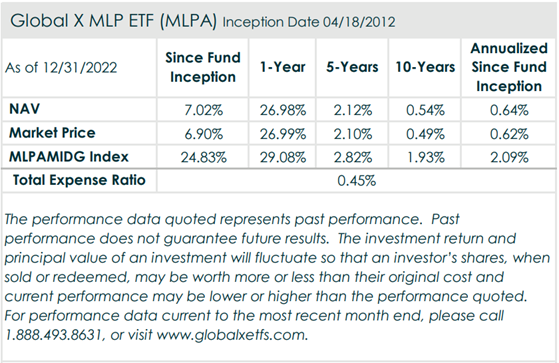The March MLP Monthly Report can be found here offering insights on MLP industry news, the asset class’s performance, yields, valuations, and fundamental drivers.
The latest quarterly MLP Insights piece providing analysis into the midstream space can be found here as well.
Summary
News
1) OPEC revised upward its forecast for global oil demand growth in 2023, the first such uptick in months, due to China’s relaxation of COVID-19-induced restrictions and the possibility of US Federal Reserve’s managing a soft landing for the US economy as further positive considerations. OPEC also forecasted a fall in supply from Russia and other non-OPEC producers, indicating a tighter market. Furthermore, the cartel expects a tighter supply-demand balance in 2023, which may bolster oil prices.
2) The energy policy tit for tat between Russia and the West continues. Russia stated that it would cut oil exports from its western ports by up to 25% in March 2023. The voluntary output cuts in March would follow the Western price caps on Russian oil and oil products imposed on December 5 and February 5.
3) The International Energy Agency has increased its projections for global oil demand by 500,000 barrels per day for the first quarter and by less than half this volume for the entire year, resulting in a projected increase in global consumption by 2 million barrels per day for the year. The agency believes the slump in the global economy will likely reverse following China’s reopening, and the nation will likely reclaim its preeminent position as the main driver of rising global oil consumption.
Sources: Lawler, A. (2023, February 14). OPEC+ raises 2023 oil demand growth view, points to tighter market. Reuters.; Reuters. (2023, February 23). Exclusive: Russia plans deep March oil export cuts, sources say.; Smith, G. (2023, February 15). IEA Boosts Global Oil Demand Forecast as China’s Economy Reopens. Bloomberg.
Performance: Midstream MLPs, as measured by the Solactive MLP Infrastructure Index, decreased by 1.40% last month. The index increased by 17.72% since last February. (Source: Bloomberg)
Yield: The current yield on MLPs stands at 7.54%. MLP yields remained higher than the Fixed Rate Preferreds (6.88%), broad market benchmarks for Investment Grade Bonds (5.51%) and lower than the High Yield Bonds (8.68%) and the Emerging Market Bonds (7.54%).1 MLP yield spreads versus 10-year Treasuries currently stand at 3.89%, lower than the long-term average of 5.61%.2 (Sources: Bloomberg; Board of Governors of the Federal Reserve System. (2023, February 28). Preformatted package: Treasury constant maturities [Data set]. Data Download Program.)
Valuations: The Enterprise Value to EBITDA ratio (EV-to-EBITDA), which seeks to provide more color on the valuations of MLPs, increased by 4.40% from last month. Since February 2022, the EV-to-EBITDA ratio is down by approximately 20.48%. (Source: Bloomberg)
Crude Production: The Baker Hughes Rig Count decreased to 753 rigs, decreasing by 18 rigs from last month’s count of 771 rigs. US production of crude oil stood at 12.300 mb/d in the last week of February increased from January levels of 12.200 mb/d. (Sources: Baker Hughes. (2023, March 8). North America rig count.; U.S. Energy Information Administration. (2023, March 8). Petroleum and other liquids.)

For performance data current to the most recent month- and quarter-end, please click here.
DEFINITIONS
Solactive MLP Infrastructure Index: The Solactive MLP Infrastructure Index is intended to give investors a means of tracking the performance of the energy infrastructure MLP asset class in the United States. The index is composed of Midstream MLPs engaged in the transportation, storage, and processing of natural resources.
S&P MLP Index: S&P MLP Index provides investors with exposure to the leading partnerships that trade on the NYSE and NASDAQ. The index includes both master limited partnerships (MLPs) and publicly traded limited liability companies (LLCs), which have a similar legal structure to MLPs and share the same tax benefits
Bloomberg US Corporate High Yield Total Return Index: The Bloomberg US Corporate High Yield Bond Index measures the USD-denominated, high yield, fixed-rate corporate bond market. Securities are classified as high yield if the middle rating of Moody’s, Fitch and S&P is Ba1/BB+/BB+ or below. Bonds from issuers with an emerging markets country of risk, based on Bloomberg EM country definition, are excluded.
ICE BofA Fixed Rate Preferred Securities Index: The ICE BofA Fixed Rate Preferred Securities Index tracks the performance of fixed rate US dollar denominated preferred securities issued in the US domestic market.
Bloomberg EM USD Aggregate Total Return Index: The Bloomberg Emerging Markets Hard Currency Aggregate Index is a flagship hard currency Emerging Markets debt benchmark that includes USD-denominated debt from sovereign, quasi-sovereign, and corporate EM issuers.
Bloomberg US Corporate Total Return Index: The Bloomberg US Corporate Total Return Value Unhedged Index measures the investment grade, fixed-rate, taxable corporate bond market. It includes USD denominated securities publicly issued by US and non-US industrial, utility and financial issuers.
Crude Oil: Measured based on the Generic 1st ‘CL’ Future, which is the nearest crude oil future to expiration.
EBITDA: Earnings before interest, tax, depreciation and amortization (EBITDA) is a measure of a company’s operating performance. Essentially, it’s a way to evaluate a company’s performance without having to factor in financing decisions, accounting decisions or tax environments.
Average Spread: Average spread is the average of the excess of the MLPs yield over the 10 year treasuries yield.
Enterprise Value (EV): EV is a measure of a company’s total value, often used as a more comprehensive alternative to equity market capitalization.
 Rohan Reddy
Rohan Reddy